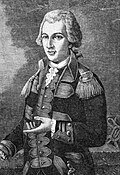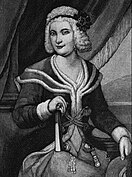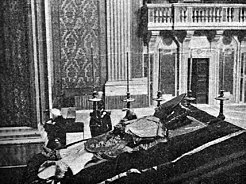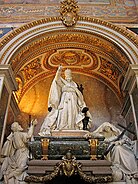Pope Leo XIII
Leo XIII | |
|---|---|
| Bishop of Rome | |
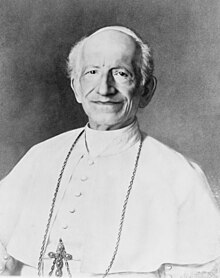 Official portrait, 1898[a] | |
| Church | Catholic Church |
| Papacy began | 20 February 1878 |
| Papacy ended | 20 July 1903 |
| Predecessor | Pius IX |
| Successor | Pius X |
| Previous post(s) |
|
| Orders | |
| Ordination | 31 December 1837 by Carlo Odescalchi |
| Consecration | 19 February 1843 by Luigi Lambruschini |
| Created cardinal | 19 December 1853 by Pius IX |
| Personal details | |
| Born | Gioacchino Vincenzo Raffaele Luigi Pecci 2 March 1810 |
| Died | 20 July 1903 (aged 93) Apostolic Palace, Rome, Kingdom of Italy |
| Motto | Lumen in coelo[1] (Light in Heaven) |
| Signature | |
| Coat of arms |  |
| Other popes named Leo | |
Ordination history of Pope Leo XIII | |||||||||||||||||||||||
|---|---|---|---|---|---|---|---|---|---|---|---|---|---|---|---|---|---|---|---|---|---|---|---|
| |||||||||||||||||||||||
| |||||||||||||||||||||||
Pope Leo XIII (Italian: Leone XIII; born Gioacchino Vincenzo Raffaele Luigi Pecci;[b] 2 March 1810 – 20 July 1903) was head of the Catholic Church from 20 February 1878 until his death in July 1903. Living until the age of 93, he was the oldest pope whose age can be validated, and had the fourth-longest reign of any pope, behind those of Peter the Apostle, Pius IX (his immediate predecessor) and John Paul II.
He is well known for his intellectualism and his attempts to define the position of the Catholic Church with regard to modern thinking. In his famous 1891 encyclical Rerum novarum, Pope Leo outlined the rights of workers to a fair wage, safe working conditions, and the formation of trade unions, while affirming the rights to property and free enterprise, opposing both socialism and laissez-faire capitalism. With that encyclical, he became popularly titled as the "Social Pope" and the "Pope of the Workers", also having created the foundations for modern thinking in the social doctrines of the Catholic Church, influencing the thoughts of his successors. He influenced the Mariology of the Catholic Church and promoted both the rosary and the scapular. Upon his election, he immediately sought to revive Thomism, the theological system of Thomas Aquinas, desiring to refer to it as the official theological and philosophical foundation for the Catholic Church. As a result, he sponsored the Editio Leonina in 1879.
Leo XIII is particularly remembered for his belief that pastoral activity in political sociology was also a vital mission of the church as a vehicle of social justice and maintaining the rights and dignities of the human person. Leo XIII issued a record of eleven papal encyclicals on the rosary, earning him the title of the "Rosary Pope". In addition, he approved two new Marian scapulars. He was the first pope never to have held any control over the Papal States, which had been dissolved by 1870, since Stephen II in the 8th century. Similarly, many of his policies were oriented towards mitigating the loss of the Papal States in an attempt to overcome the loss of temporal power, but nonetheless continuing the Roman Question.
After his death in 1903, he was buried in the Vatican Grottoes before his remains were later transferred in 1924 to the Basilica of Saint John Lateran.
Early life and education, 1810–1836
[edit]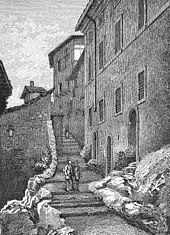
Born in Carpineto Romano, near Rome, he was the sixth of the seven children of Count Ludovico Pecci (1767–1833) and his wife, Anna Francesca Prosperi Buzzi (1773–1824).[2] His brothers included Giuseppe and Giovanni Battista Pecci. Until 1818, he lived at home with his family "in which religion counted as the highest grace on earth, as through her, salvation can be earned for all eternity".[3] Together with Giuseppe, he studied in the Jesuit College in Viterbo until 1824.[4] He enjoyed Latin and was known to have written his own Latin poems at the age of eleven.[c] Leo was a descendant of the Italian leader Cola di Rienzo on his mother's side. [6]
His siblings were:[7]
- Carlo (1793–1879)
- Anna Maria (1798–1870)
- Caterina (1800–1867)
- Giovanni Battista (1802–1881)
- Giuseppe (1807–1890)
- Fernando (1813–1830)
In 1824, he and Giuseppe were called to Rome, where their mother was dying. Count Pecci wanted his children near him after the loss of his wife and so they stayed with him in Rome and attended the Jesuit Collegium Romanum.
In 1828, the 18-year-old Vincenzo decided in favour of secular clergy, and Giuseppe entered the Jesuit order.[8] Vincenzo studied at the Academia dei Nobili, mainly diplomacy and law. In 1834, he gave a student presentation, attended by several cardinals, on papal judgments. For his presentation, he received awards for academic excellence and gained the attention of Vatican officials.[9] Cardinal Secretary of State Luigi Lambruschini introduced him to Vatican congregations. During a cholera epidemic in Rome, he assisted Cardinal Giuseppe Antonio Sala in his duties as overseer of all the city hospitals.[10] In 1836, he received his doctorate in theology and doctorates of civil and Canon Law in Rome.
Provincial administrator, 1837–1843
[edit]On 14 February 1837, Pope Gregory XVI appointed the 27-year-old Pecci as personal prelate even before he was ordained a priest on 31 December 1837 by the Cardinal Vicar Carlo Odescalchi. He celebrated his first Mass with his priest brother Giuseppe.[11] Shortly thereafter, Gregory XVI appointed Pecci as Papal legate (provincial administrator) to Benevento, the smallest Papal province, with a population of about 20,000.[10]
The main problems facing Pecci were a decaying local economy, insecurity from widespread bandits, and pervasive Mafia or Camorra structures, which were often allied with aristocratic families. Pecci arrested the most powerful aristocrat in Benevento and his troops captured others, who were either killed or imprisoned by him. With public order restored, he turned to the economy and a reform of the tax system to stimulate trade with the neighboring provinces.[12]
Pecci was first destined for Spoleto, a province of 100,000. On 17 July 1841, he was sent to Perugia with 200,000 inhabitants.[10] His immediate concern was to prepare the province for a papal visitation in the same year. Pope Gregory XVI visited hospitals and educational institutions for several days, asking for advice and listing questions. The fight against corruption continued in Perugia, where Pecci investigated several incidents. When it was claimed that a bakery was selling bread below the prescribed pound weight, he personally went there, had all bread weighed and confiscated it if below legal weight. The confiscated bread was distributed to the poor.[13]
Nuncio to Belgium, 1843–1846
[edit]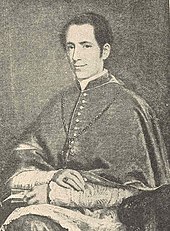
In 1843, Pecci, at only 33, was appointed Apostolic Nuncio to Belgium,[14] a position that guaranteed the cardinal's hat after completion of the tour.
On 27 April 1843, Pope Gregory XVI appointed Pecci Archbishop and asked his Cardinal Secretary of State Lambruschini to consecrate him.[14] Pecci developed excellent relations with the royal family and used the location to visit neighboring Germany, where he was particularly interested in the architectural completion of the Cologne Cathedral.
In 1844, upon his initiative, a Belgian College in Rome was opened; 102 years later, in 1946, the future Pope John Paul II would begin his Roman studies there. Pecci spent several weeks in England with Bishop Nicholas Wiseman, carefully reviewing the condition of the Catholic Church in that country.[15]
In Belgium, the school question was sharply debated between the Catholic majority and the liberal minority. Pecci encouraged the struggle for Catholic schools, but he was able to win the good will of the Court not only of the pious Queen Louise but also of King Leopold I, who was strongly liberal in his views. The new nuncio succeeded in uniting Catholics. At the end of his mission, the King granted him the Grand Cordon in the Order of Leopold.[16]
Archbishop-Bishop of Perugia, 1846–1878
[edit]Papal assistant
[edit]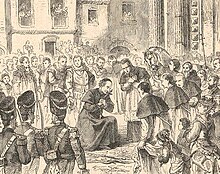
In 1843, Pecci had been named papal assistant. From 1846 to 1877, he was considered a popular and successful Archbishop of Perugia. In 1847, after Pope Pius IX granted unlimited freedom for the press in the Papal States,[17] Pecci, who had been highly popular in the first years of his episcopate, became the object of attacks in the media and at his residence.[18] In 1848, revolutionary movements developed throughout Western Europe, including France, Germany and Italy. Austrian, French and Spanish troops reversed the revolutionary gains but at a price for Pecci and the Catholic Church, who could not regain their former popularity.
Provincial council
[edit]Pecci called a provincial council in 1849 to reform the religious life in his dioceses in Spoleto and it was in this council that the need for a Syllabus of Errors was discussed.[19][20] He invested in enlarging the seminary for future priests and in hiring new and prominent professors, preferably Thomists. He called on his brother Giuseppe Pecci, a noted Thomist scholar, to resign his professorship in Rome and to teach in Perugia instead.[21] His own residence was next to the seminary, which facilitated his daily contacts with the students.
Charitable activities
[edit]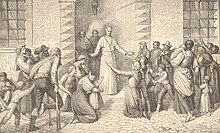
While archbishop, Pecci developed several activities in support of various Catholic charities. He founded homeless shelters for boys, girls and elderly women. Throughout his dioceses, he opened branches of a Bank, Monte di Pietà, which focused on low-income people and provided low-interest loans.[22] He created soup kitchens, which were run by the Capuchins. Upon his elevation to the cardinalate in late 1853, and in light of continuing earthquakes and floods, he donated all resources for the festivities of his elevation to the victims. Much of the public attention turned on the conflict between the Papal States and Italian nationalism, which aimed at the Papal States' annihilation to achieve the Unification of Italy.
Cardinalate
[edit]In the consistory of 19 December 1853, he was elevated to the College of Cardinals, as Cardinal-Priest of San Crisogono. Pope Gregory XVI originally intended to name him as a cardinal; however, his death in 1846 put pause to that idea while the events that characterized the beginning of the papacy of Pius IX further postponed the idea of Pecci's elevation. By the time that Gregory XVI died, Leopold II repeatedly asked that Pecci be named as a cardinal.[23] While Pius IX strongly desired having Pecci as close to Rome as possible, and repeatedly offered him a suburbicarian diocese, Pecci continually refused due to his preference for Perugia. It is possible that the archbishop did not share the views of the Cardinal Secretary of State, Giacomo Antonelli. It is not true that Pius IX deliberately sent him to Perugia as a way of exiling him from Rome simply because Pecci's views were perceived to be liberalistic and conciliatory, as opposed to the conservatism of the papal court.[23]
Allegedly, Pecci had been a cardinal reserved "in pectore" by Gregory XVI in the consistory of 19 January 1846, with the pope's death just over four months later invalidating the appointment since his name was never actually revealed publicly.[7]
Defending the papacy
[edit]Pecci defended the papacy and its claims. When Italian authorities expropriated convents and monasteries of Catholic orders, turning them into administration or military buildings, Pecci protested but acted moderately. When the Italian state took over Catholic schools, Pecci, fearing for his theological seminary, simply added all secular topics from other schools and opened the seminary to non-theologians.[24] The new government also levied taxes on the Catholic Church and issued legislation according to which all episcopal or papal utterances were to be approved by the government before their publication.[25]
Organizing the First Vatican Council
[edit]On 8 December 1869, an ecumenical council, which became known as the First Vatican Council, was to take place in the Vatican per Pope Pius IX. Pecci was likely well informed since the pope named his brother Giuseppe to help prepare the event.
During the 1870s, in his last years in Perugia, Pecci addressed the role of the church in modern society several times, defining the church as the mother of material civilization because it upheld human dignity of working people, opposed the excesses of industrialization and developed large-scale charities for the needy.[26]
In August 1877, on the death of Cardinal Filippo de Angelis, Pope Pius IX appointed him Camerlengo, which required him to reside in Rome.[27] Reportedly, Pius IX is alleged to have said to Pecci: "Monsignor, I have decided to summon you to the Senate of the Church. I feel sure this will be the first act of my pontificate that you will not feel called upon to criticize". These comments were reported to have been said due to the stories that Pecci and Pius IX had a mutual animosity for each other and disagreed with each other in terms of policy; however, this purported animosity has never been proven. It was further alleged that by this stage Pecci desired a change of scenery from Perugia and hoped for either the bishopric of Albano or the position of datary of the Apostolic Dataria. It has also been said that Pecci was reportedly in line to succeed Cardinal Alessandro Barnabò as the prefect for Propaganda Fide; however, it was stymied by his opponent, Cardinal Antonelli.[7]
Papacy, 1878–1903
[edit]Election
[edit]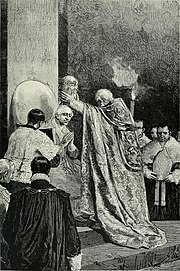
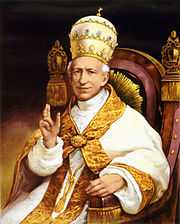
Pope Pius IX died on 7 February 1878,[27] and during his closing years the liberal press had often insinuated that the Kingdom of Italy should take a hand in the conclave and occupy the Vatican.[citation needed] However, the Russo-Turkish War (1877–1878) and the sudden death of King Victor Emmanuel II (9 January 1878) distracted the government's attention.
In the conclave, the cardinals faced varied questions and discussed issues like church–state relations in Europe, specifically Italy; divisions in the church and the status of the First Vatican Council. It was also debated that the conclave be moved elsewhere, but Pecci decided otherwise in his capacity as the camerlengo. On 18 February 1878, the conclave assembled in Rome. Cardinal Pecci was elected on the third ballot and chose the name Leo XIII.[27] He was crowned on 3 March 1878.
During the conclave, he secured his election on the third scrutiny with 44 out of 61 votes, more than the requisite two-thirds majority. While the 1878 conclave was characterized by fewer political influences than in previous conclaves due to a variety of European political crises, it was generally believed that the long papacy of the conservative Pius IX led many of the cardinals to vote for Pecci because his age and health created the expectation that his papacy would be somewhat brief.[28] Following the conclave, John Henry Newman is reported to have said, "In the successor of Pius IX recognize a depth of thought, a tenderness of heart, a winning simplicity, and a power answering to the name of Leo, which prevent me from lamenting that Pius is no longer here".[28] In the conclave, Pecci was perceived as the main "papabile" candidate; however, Cardinals Flavio Chigi and Tommaso Martinelli were also considered as potential candidates. But some cardinals who opposed Pecci, and were alarmed at the rising votes he was securing, banded together to cast their ballots for Cardinal Alessandro Franchi; however, Franchi secured no votes in the final ballot that saw Pecci duly elected. Allegedly, those who were dedicated to thwarting his election were Cardinals Luigi Oreglia di Santo Stefano, Pietro Giannelli, Chigi, Lorenzo Ilarione Randi, Carlo Sacconi, Raffaele Monaco La Valletta, Luigi Amat di San Filippo e Sorso, and Johann Baptist Franzelin. It was also suggested that, before his death, Pius IX heavily favored Cardinal Luigi Bilio to succeed him, and while many of the cardinals created by the late pope intended to vote for Bilio to honor the man that elevated them in the first place, they feared that voting for an ultra-conservative could potentially evoke a veto from one of the European powers and stall the election more than was necessary. To that end, there had been early talks about Austria possibly vetoing Bilio; however, this never occurred.[28] Before the conclave, Cardinals Domenico Bartolini, Monaco, Bilio, Henry Edward Manning, Lorenzo Nina, and Franchi (proposed by Pecci's opponents) all agreed on supporting Pecci's candidacy, also determining that the next pope needed to be an Italian. Both Manning and Edward Henry Howard agreed to persuade the foreign cardinals to back Pecci's candidacy.[29][28]
Upon his election, he announced that he would assume the name "Leo" in memory of Pope Leo XII due to his admiration for the late pope's interest in education and his conciliatory attitude toward foreign governments.[29] When asked what name he would take, the new pope responded: "As Leo XIII, in remembrance of Leo XII, whom I have always venerated". His election was formally announced to the people of Rome and the world at 1:15 pm.[7]
He retained the administration of the Perugia see until 1880.
Pontificate
[edit]| Part of a series on |
| Catholic social teaching |
|---|
 |
| Overview |
|
|
As soon as he was elected to the papacy, Leo XIII worked to encourage understanding between the church and the modern world. When he firmly reasserted the scholastic doctrine that science and religion coexist, he required the study of Thomas Aquinas[30] and opened the Vatican Secret Archives to qualified researchers, among whom was the noted historian of the Papacy Ludwig von Pastor. He also refounded the Vatican Observatory "so that everyone might see clearly that the Church and her Pastors are not opposed to true and solid science, whether human or divine, but that they embrace it, encourage it, and promote it with the fullest possible devotion."[31]

Leo XIII brought normality back to the Catholic Church after the tumultuous years of Pius IX. Leo's intellectual and diplomatic skills helped regain much of the prestige lost with the fall of the Papal States. He tried to reconcile the church with the working class, particularly by dealing with the social changes that were sweeping Europe. The new economic order had resulted in the growth of an impoverished working class who had increasing anticlerical and socialist sympathies. Leo helped reverse that trend.
Although Leo XIII was no radical in either theology or politics, his papacy moved the Catholic Church back to the mainstream of European life. Considered a great diplomat, he managed to improve relations with Russia, Germany, France, Britain and other countries.
Pope Leo XIII was able to reach several agreements in 1896 that resulted in better conditions for the faithful and additional appointments of bishops. During the fifth cholera pandemic in 1891, he ordered the construction of a hospice inside the Vatican. That building would be torn down in 1996 to make way for construction of the Domus Sanctae Marthae.[32]
Leo was a drinker of the cocaine-infused wine tonic Vin Mariani, a precursor drink to Coca-Cola.[33] He awarded a Vatican gold medal to the wine's creator, Angelo Mariani, and also appeared on a poster endorsing it.[34] Leo XIII was a semi-vegetarian. In 1903, he attributed his longevity to the sparing use of meat and the consumption of eggs, milk and vegetables.[35]
His favourite poets were Virgil and Dante.[36]
Foreign relations
[edit]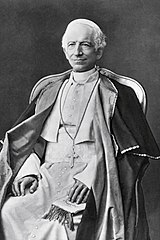
Russia
[edit]Pope Leo XIII began his pontificate with a friendly letter to Tsar Alexander II in which he reminded the Russian monarch of the millions of Catholics living in his empire who would like to be good Russian subjects if their dignity were respected.
After the assassination of Alexander II, the pope sent a high ranking representative to the coronation of his successor, Alexander III, who was grateful and asked for all religious forces to unify. He asked the pope to ensure that his bishops abstain from political agitation. Relations improved further when Pope Leo XIII, because of Italian considerations, distanced the Vatican from the Rome-Vienna-Berlin alliance, and helped to facilitate a rapprochement between Paris and St. Petersburg.
Germany
[edit]Under Otto von Bismarck, the anti-Catholic Kulturkampf in Prussia led to significant restrictions on the Catholic Church in the German Empire, including the Jesuits Law of 1872. During Leo's papacy, compromises were informally reached and the anti-Catholic attacks subsided.[37]
The Centre Party in Germany represented Catholic interests and was a force for social change. It was encouraged by Leo's support for social welfare legislation and the rights of working people. Leo's forward-looking approach encouraged Catholic Action in other European countries, where the social teachings of the church were incorporated into the agenda of Catholic parties, particularly the Christian democratic parties, which became an acceptable alternative to socialist parties. Leo's social teachings were reiterated throughout the 20th century by his successors.
In his Memoirs,[38] Emperor Wilhelm II discussed the "friendly, trustful relationship that existed between me and Pope Leo XIII." During Wilhelm's third visit to Leo: "It was of interest to me that the Pope said on this occasion that Germany must be the sword of the Catholic Church. I remarked that the old Roman Empire of the German nation no longer existed, and that conditions had changed. But he adhered to his words."
France
[edit]Leo XIII possessed a great affection for France, and feared that the Third Republic would take advantage of the fact that most French Catholics were Royalists to abolish the Concordat of 1801. At the advisement of Cardinal Rampolla, he urged French Catholics to "rally" to the republic.[39] Leo's decision upset many French monarchists, who felt they were being forced to betray their king for their faith. Ultimately, this move split the French Church politically and decreased its influence in France. Leo's move also failed to prevent the Concordant's eventual repealment, as it was later abrogated by the 1905 French law on the Separation of the Churches and the State.[40]
Italy
[edit]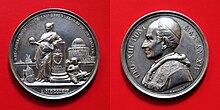
In the light of a climate hostile to the Catholic Church, Leo continued the policies of Pius IX towards Italy without major modifications.[41] In his relations with the Italian state, Leo continued the Papacy's self-imposed incarceration-in-the-Vatican stance and continued to insist that Italian Catholics should not vote in Italian elections or hold any elected office. In his first consistory in 1879, he elevated his older brother, Giuseppe, to the cardinalate. He had to defend the freedom of the church against what Catholics considered Italian persecution and discrimination in the area of education, expropriation and violation of Catholic Churches, legal measures against the church and acts of terrorism such as anticlerical groups attempting to throw the corpse of Pope Pius IX into the Tiber on 13 July 1881.[42] The pope even considered moving his residence to Trieste or Salzburg, two cities in Austria, an idea that Emperor Franz Joseph I gently rejected.[43]
United Kingdom
[edit]Among the activities of Leo XIII that were important for the English-speaking world, he restored the Scottish hierarchy in 1878. The following year, on 12 May 1879, he raised to the rank of cardinal the convert theologian John Henry Newman,[44] who would eventually be beatified by Pope Benedict XVI in 2010 and canonized by Pope Francis in 2019. In British India, too, Leo established a Catholic hierarchy in 1886 and regulated some longstanding conflicts with the Portuguese authorities. A papal rescript (20 April 1888) condemned the Irish Plan of Campaign and all clerical involvement in it as well as boycotting, followed in June by the papal encyclical "Saepe Nos"[45] that was addressed to all the Irish bishops. Of outstanding significance, not least for the English-speaking world, was Leo's encyclical Apostolicae curae on the invalidity of the Anglican orders, published in 1896. In 1899, he declared Bede the Venerable a Doctor of the Church.
Spain
[edit]In 1880, the Santa Maria de Montserrat Abbey in Catalonia celebrated 1000 years of existence. On 11 September 1881, to coincide with the Catalan national day, Leo XIII proclaimed the Virgin of Montserrat to be Patron of Catalonia. This had implications beyond the purely religious sphere, influencing the development of Catalan nationalism.
Bulgaria
[edit]Leo XIII welcomed the elevation of Prince Ferdinand of Saxe-Coburg (the later Ferdinand I of Bulgaria) to Prince of Bulgaria in 1886. A fellow Catholic, whose wife was a member of the Italian House of Bourbon-Parma, the two had a lot in common. However, relations between the two degenerated when Ferdinand expressed his intention to allow his eldest son Crown Prince Boris (later Tsar Boris III) to convert to Orthodoxy, the majority religion of Bulgaria. Leo strongly condemned the action, and when Ferdinand went through with the conversion anyway, Leo excommunicated him.
United States
[edit]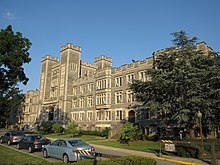
The United States frequently attracted his attention and admiration. He confirmed the decrees of the Third Plenary Council of Baltimore (1884) and raised James Gibbons, the archbishop of that city, to the cardinalate in 1886.
On 10 April 1887, a pontifical charter from Pope Leo XIII founded the Catholic University of America, establishing the national university of the Catholic Church in the United States.
American newspapers criticized Pope Leo because they claimed that he was attempting to gain control of American public schools.[46] One cartoonist drew Leo as a fox unable to reach grapes that were labeled for American schools; the caption read "Sour grapes!"[47]
In 1892, Pope Leo XIII opened the Vatican archives to William Eleroy Curtis, a special envoy planning the commemoration of Christopher Columbus at the 1893 World's Columbian Exposition.[48][49]
Brazil
[edit]Pope Leo XIII is remembered for the First Plenary Council of Latin America held at Rome in 1899, and for his encyclical of 1888 to the bishops of Brazil, In plurimis, on the abolition of slavery. In 1897 he published the Apostolic Letter Trans Oceanum, which dealt with the privileges and ecclesiastical structure of the Catholic Church in Latin America.[50]
Chile
[edit]He bestowed his pontifical benediction over Chilean troops on the eve of the Battle of Chorrillos during the War of the Pacific in January 1881. The Chilean soldiers looted the cities of Chorrillos and Barranco, including the churches, and their chaplains headed the robbery at the Biblioteca Nacional del Perú, where the soldiers ransacked various items along with much capital, and Chilean Priests coveted rare and ancient editions of the Bible that were stored there.[51][better source needed]
India
[edit]Pope Leo XIII urged "Filii tui India, administri tibi salutis" (Your own sons, O India, will be the heralds of your salvation)[52] and founded the national seminary, called Papal Seminary. He entrusted this task to the then Apostolic Delegate to India Ladislaus Michael Zaleski, who founded the Seminary in 1893.
Philippines
[edit]Leo XIII was pope during the Spanish–American War in 1898, in which the United States, a then largely Protestant nation, took control of the Philippines from Spain. In a 1902 meeting with Philippine Governor-General William Howard Taft, Leo XIII refused to allow the United States government to buy land from Catholic friars in the Philippines.[53]
Evangelization
[edit]Pope Leo XIII sanctioned the missions to Eastern Africa beginning in 1884.[44] In 1887, he approved the foundation of Missionaries of St. Charles Borromeo, which were organized by the Bishop of Piacenza, Giovanni Battista Scalabrini. The missionaries were sent to North and South America to do pastoral care for Italian immigrants. In 1879 Catholic missionaries associated with the White Father Congregation (Society of the Missionaries of Africa) came to Uganda and others went to Tanganyika (present-day Tanzania) and Rwanda.[54]
Theology
[edit]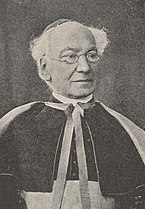
Leo XIII also approved a number of Scapulars. In 1885, he approved the Scapular of the Holy Face, (also known as The Veronica) and elevated the Priests of the Holy Face to an archconfraternity.[56] He also approved the Scapular of Our Lady of Good Counsel and the Scapular of St. Joseph, both in 1893, and the Scapular of the Sacred Heart in 1900.[57]
Thomism
[edit]As pope, he used all his authority for a revival of the theology of Thomas Aquinas. On 4 August 1879, Leo XIII promulgated the encyclical Aeterni Patris ("Eternal Father"), which, more than any other single document, provided a charter for the revival of Thomism, the medieval theological system based on the thought of Aquinas – as the official philosophical and theological system of the Catholic Church. It was to be normative not only in the training of priests but also in the education of the laity at universities.
Pope Leo XIII later created the Pontifical Academy of St. Thomas Aquinas on 15 October 1879 and ordered the publication of the critical edition, the so-called Leonine Edition, of the complete works of the doctor angelicus. The superintendence of the Leonine edition was entrusted to Tommaso Maria Zigliara, professor and rector of the Collegium Divi Thomae de Urbe, the future Pontifical University of Saint Thomas Aquinas, today called Angelicum. Leo also founded the Angelicum's Faculty of Philosophy in 1882 and its Faculty of Canon Law in 1896.[citation needed]
Consecrations
[edit]
Pope Leo XIII performed a number of consecrations, at times entering new theological territory. After he had received many letters from Sister Mary of the Divine Heart, the countess of Droste zu Vischering and Mother Superior in the Convent of the Good Shepherd Sisters in Porto, Portugal, asking him to consecrate the entire world to the Sacred Heart of Jesus, he commissioned a group of theologians to examine the petition on the basis of revelation and sacred tradition. The outcome of this investigation was positive and so in the encyclical letter Annum sacrum (on 25 May 1899), he decreed that the consecration of the entire human race to the Sacred Heart of Jesus should take place on 11 June 1899.[citation needed]
The encyclical letter also encouraged the entire Catholic episcopate to promote the First Friday Devotions, established June as the Month of the Sacred Heart, and included the Prayer of Consecration to the Sacred Heart.[59] His consecration of the entire world to the Sacred Heart of Jesus presented theological challenges in consecrating non-Christians. Since about 1850, various congregations and countries had consecrated themselves to the Sacred Heart, a practice common at the time throughout the Catholic world.
Prayer
[edit]Leo introduced the promotion of monthly prayer intentions in 1890, which he entrusted to the Apostleship of Prayer (now the Pope's Worldwide Prayer Network).[60]
Scriptures
[edit]In his 1893 encyclical Providentissimus Deus, he described the importance of scriptures for theological study. It was an important encyclical for Catholic theology and its relation to the Bible, as Pope Pius XII pointed out 50 years later in his encyclical Divino afflante Spiritu.[61]
Eastern Rite Catholics
[edit]He devoted his encyclical "Orientalium dignitas" of 1894 to preserving Eastern Rite liturgies.[citation needed]
Theological research
[edit]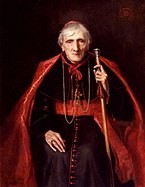
Leo XIII is credited with great efforts in the areas of scientific and historical analysis. He opened the Vatican Archives and personally fostered a 20-volume comprehensive scientific study of the Papacy by Ludwig von Pastor, an Austrian historian.[62]
Mariology
[edit]His predecessor, Pope Pius IX, became known as the Pope of the Immaculate Conception because of his dogmatization in 1854. Leo XIII, in light of his unprecedented promulgation of the rosary in 11 encyclicals, was called the Rosary Pope because he promulgated Marian devotion. In his encyclical on the 50th anniversary of the Dogma of the Immaculate Conception, he stresses Mary's role in the redemption of humanity and calls her Mediatrix and Co-Redemptrix. While allowing the title "Mediatrix", recent popes, following on the Second Vatican Council, have warned away from the term "co-redemptrix" as derogating from the one mediator, Jesus Christ.[63][64][65]
Social teachings
[edit]| Part of a series on |
| Christian democracy |
|---|
 |
|
|
Rerum novarum
[edit]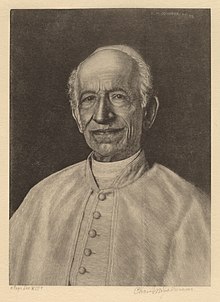
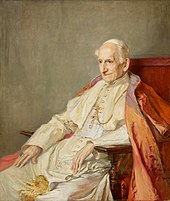
His encyclicals changed the church's relations with temporal authorities; the 1891 encyclical Rerum novarum, for the first time, addressed social inequality and social justice issues with papal authority by focusing on the rights and duties of capital and labour. He was greatly influenced by Wilhelm Emmanuel von Ketteler, a German bishop who propagated siding with the suffering working classes in his book Die Arbeiterfrage und das Christentum. Since Leo XIII, many papal teachings have expanded on the rights and obligations of workers. Leo argued that both capitalism and communism are flawed. Rerum novarum introduced the idea of subsidiarity, the principle that political and social decisions should be taken at a local level, if possible, rather than by a central authority, into Catholic social thought.[citation needed]
Consistories
[edit]Throughout his pontificate, Leo XIII elevated 147 cardinals in 27 consistories. While the limit of the College of Cardinals had been set at 70 since the papacy of Pope Sixtus V, Leo XIII never exceeded nor reached the limit, only ever coming close at 67 in 1901.[66] Amongst the noteworthy cardinals whom he elevated, he named John Henry Newman as a cardinal while also elevating his own brother Giuseppe Pecci, though not a nepotistic act (it was based purely on recommendation and merit), in the same consistory. In 1893, he elevated Giuseppe Melchiorre Sarto to the cardinalate, who would go on to be his immediate successor, Pope Pius X in 1903. The pope also nominated the brothers, Serafino and Vincenzo Vannutelli and the cousins Luigi and Angelo Jacobini to the Sacred College. Other noteworthy inclusions were Andrea Carlo Ferrari (later beatified in 1987) and Girolamo Maria Gotti.[citation needed]
Of the 147 cardinals he elevated, 85 were Italian since Leo XIII nominated cardinals from beyond Europe, including the first cardinals from Australia,[67] Canada,[68] Slovenia,[69] and Armenia,[70] the latter of which would be the first Oriental selection since 1439.
In 1880, the pope named three cardinals "in pectore", announcing them in 1882 and 1884. In 1882, he named another cardinal in pectore, announcing the name later that same year. On 30 December 1889, Leo XIII named only one cardinal whom he reserved in pectore, only announcing the name roughly six months later. In early 1893, he named another two cardinals in pectore, announcing their names in 1894 and 1895, while in April 1901 announcing the names of another two cardinals whom he had reserved in pectore in June 1899. In June 1896, Leo XIII named two other cardinals in pectore, announcing in March 1898 that both had died, hence, vacating the red hats he would have bestowed upon them.[71]
With the elevation of Newman in 1879, it was widely praised throughout the English-speaking world, not simply on the account of Newman's virtues and reputation, but on the basis that Leo XIII had a broader episcopal vision in mind than Pius IX ever did. His similar appointments of two prominent participants of the First Vatican Council, Lajos Haynald and Friedrich Egon von Fürstenberg both in 1879 was also noteworthy due to their roles in the short-lived Council. It was even alleged that Félix Antoine Philibert Dupanloup, a vocal opponent of papal infallibility like Newman, would have been elevated to the cardinalate in 1879 had he not died in October 1878.[28] Additionally, in 1884, the Polish priest and former Curial official Stefan Pawlicki was offered but refused an offer of elevation. Leo XIII later intended to name the Archbishop of Santiago Mariano Santiago Casanova Casanova as a cardinal in 1895; however, the pope abandoned the idea after the Peruvian Church objected that the Archbishop of Lima was the Primate of South America and hence the one that needed to be made a cardinal. In order to avoid a conflict between Chile and Peru, the pope abandoned the idea reluctantly.[71]
In 1897, the pope intended to name the Archbishop of Turin Davide Riccardi as a cardinal but the cardinal died before the promotion could take place. In 1891 and again in 1897, the pope offered the cardinalate to Johannes Montel Edler von Treuenfels, the dean of the Sacred Rota, though he refused the honor (he refused again in 1908 when invited by Pope Pius X). In 1899, Leo XIII hoped to nominate the Dominican procurator general Hyacinthe-Marie Cormier (later beatified) to the cardinalate; however, he was unable to do so because the French government did not favor a cardinal from a religious order to seek its best interests as a Curial member.[71] In 1901, he planned to name Agapito Panici as a cardinal at the next consistory, but Panici died before the nomination could take place in 1903. Allegedly, before deciding to name him, Leo XIII asked his brother Diomede to renounce his claim to the red hat, but when Agapito died in 1902, the pope informed Diomede that he would ignore his previous missive asking him to renounce his claim to the red hat, a position that Diomede was never then given. According to witnesses, Leo XIII failed three times to invite Vincenzo Tarozzi (whose cause for beatification has since been launched) to receive the red hat. According to a conversation in 1904 between Pope Pius X and Antonio Mele-Virdis, the former is alleged to have said, "he should have been in my place".[71]
Canonizations and beatifications
[edit]Leo XIII canonized the following saints during his pontificate:
- 8 December 1881: Clare of Montefalco (d. 1308), John Baptist de Rossi (1696–1764), Lawrence of Brindisi (d. 1619), and Benedict Joseph Labre (1748–1783)
- 15 January 1888: Seven Holy Founders of the Servite Order, Peter Claver (1581–1654), John Berchmans (1599–1621), and Alphonsus Rodriguez (1531–1617)
- 27 May 1897: Anthony Zaccaria (1502–1539) and Peter Fourier (1565–1640)
- 24 May 1900: John Baptist de la Salle (1651–1719) and Rita of Cascia (1381–1457)
Leo XIII beatified several of his predecessors: Urban II (14 July 1881), Victor III (23 July 1887) and Innocent V (9 March 1898). He canonized Adrian III on 2 June 1891.
He also beatified the following:
- Giancarlo Melchiori on 22 January 1882
- Edmund Campion and Ralph Sherwin in 1886
- John Haile on 29 December 1886
- Jean-Baptiste de La Salle (whom he later canonized) on 19 February 1888
- Inés de Benigánim on 26 February 1888
- Antonio Maria Zaccaria (whom he later canonized) on 3 January 1890
- Giovanni Giovenale Ancina on 9 February 1890
- Pompilio Maria Pirrotti on 26 January 1890
- Gerard Majella on 29 January 1893
- Leopoldo Croci on 12 May 1893
- Antonio Baldinucci on 16 April 1893
- Rodolfo Acquaviva and 4 Companions on 30 April 1893
- Diego José López-Caamaño on 22 April 1894
- Bernardino Realino on 12 January 1896
- Francis Regis Clet on 27 May 1900
- Ignatius Delgado y Cebrian as one of 64 Martyrs of Vietnam on 27 May 1900
- Louis Gabriel Taurin Dufresse on 27 May 1900
- John Lantrua of Triora on 27 May 1900
- Maria Maddalena Martinengo on 3 June 1900
- Dénis Berthelot of the Nativity and Redento Rodríguez of the Cross on 10 June 1900[72]
- Jeanne de Lestonnac on 23 September 1900
- Antonio Grassi on 30 September 1900
He approved the cult of Cosmas of Aphrodisia. He beatified several of the English martyrs in 1895.[73]
Doctors of the Church
[edit]Leo XIII named four individuals as Doctors of the Church:
- Cyril of Alexandria (28 July 1882) – he named him as "Doctor Incarnationis" ("Doctor of the Incarnation")
- Cyril of Jerusalem (28 July 1882)
- John of Damascus (29 August 1890)
- Bede the Venerable (13 November 1899) – he named him as "Anglorum doctor" ("Doctor of the English")
Audiences
[edit]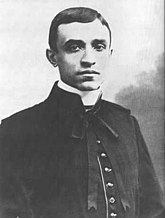
One of the first audiences that Leo XIII granted was to the professors and students of the Collegio Capranica, where in the first row knelt in front of him the young seminarian Giacomo Della Chiesa, the future Pope Benedict XV, who would be pope from 1914 to 1922.
On a pilgrimage with her father and sister in 1887, Thérèse of Lisieux attended a general audience with Pope Leo XIII and asked him to allow her to enter the Carmelite order. Even though she was strictly forbidden to speak to him because she was told that it would prolong the audience too much, she addressed him and obtained his permission to enter the noviciate early.[citation needed]
There are several versions of a story of how Leo came to compose the Prayer to Saint Michael. Various dates are given. A common account says that on the morning of 13 October 1884, Leo XIII celebrated Mass but as he finished, he turned to step down the stairs and allegedly collapsed, falling into what was originally thought to be a coma, but was rather a mystical ecstasy. As the priests and cardinals rushed to his side, Leo XIII rose and visibly shaken, brushed off his aides and rushed back towards his apartment where he immediately wrote the Prayer to Saint Michael the Archangel. Leo XIII reportedly saw a vision of demons being released from Hell, and as the vision ended, he saw Saint Michael charge in and drive them all back into Hell. Leo XIII mandated that the prayer be said after every Mass from that point forth.[citation needed]
In 1934, a German writer, Fr. Bers, tried to trace the origin of the story and declared that, though the story was widespread, nowhere could he find a trace of proof. Sources close to the institution of the prayer in 1886, including an account of a conversation with Leo XIII about his decision, say nothing of the alleged vision. Bers concluded that the story was a later invention that spread like a virus.[74]
Health
[edit]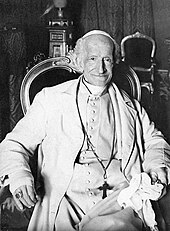
At the time of his election in 1878, the pope had started to experience a slight tremor in his hand due to a poorly undertaken bloodletting procedure for a previous malady.[75]
In March 1899, it had been believed that the pope was gravely ill and that he was nearing death. Originally, it was presumed that the pope was suffering from a violent case of pneumonia and that the alarm was raised regarding his health. However, it was soon discovered that the reason for the pope's illness was the sudden inflammation of a cyst which had been troubling him for almost thirty years and which had never been previously removed. The only reason it had never been of any particular concern was due to incisions designed for pain relief. While Leo XIII strongly rejected the notion of surgery at first, he was persuaded by Cardinal Mariano Rampolla del Tindaro that it was necessary to ensure his good health. Before the pope was taken for surgery, he asked that his chaplain celebrate Mass in his private chapel while the operation was taking place. Reportedly, the cyst removed "was the size of an ordinary-sized orange."[75][76]
Towards the end of his life, Leo XIII resorted to using a gold-headed cane when going on walks, as he often found it difficult to do so. While Leo XIII was certainly able to walk without it, he only did so if he felt truly comfortable in doing so. When there were ever rumors about his health, Leo XIII was known to mischievously walk about briskly to dispel the rumors.[7]
Death
[edit]On 30 June 1903, Leo XIII reported slight feelings of dyspepsia and said that he would take a dose of castor oil to help himself recuperate, shrugging off concerns about his health. While it seemed to work, and the pope resumed his duties with a renewed vigor, it was not to last.[76]
Leo XIII originally contracted a cold while taking an outing in the Vatican Gardens on 3 July 1903; however, his condition rapidly deteriorated to the point that he had contracted pneumonia. That night, he immediately went to bed and lost consciousness.[76][77] Originally, the pope refused his doctor's desire to secure a second opinion from a colleague, insisting on a doctor who had previously tended to him in 1899 when he suffered a previous serious illness.[78] When the doctor was immediately summoned to the pope's bedside, he determined that the castor oil had disturbed his stomach and exacerbated his condition.[76] The pope's nephews were immediately notified of their uncle's illness, as were Cardinals Mariano Rampolla del Tindaro and Luigi Oreglia di Santo Stefano in their capacities as the Secretary of State and Camerlengo respectively. On 4 July, the pope made his last confession to Cardinal Serafino Vannutelli and later was barely able to recite the profession of faith.[78] That same day, he experienced a loss of appetite and suffered from shortness of breath.[75] On 5 July, the doctor said reported that the hepatisation affected the upper and middle lobes of the right lung, while Leo XIII suffered from considerable cardiac weakness and difficulties in breathing, while reporting the absence of any fever or coughing fits.[76] That same day, after having received the sacraments, the pope said, "I am now near my end. I do not know if all I have done has been good, but I certainly obeyed my conscience and our faith".[7]
On 6 July 1903, he was administered an injection to ease the pain that he was experiencing, while it was reported that the pneumonia he had contracted was starting to spread to the left lung. The pope, who had an imperceptible pulse, had a restless night and was given oxygen by his doctors. When given the oxygen, Leo XIII replied, "That is much better. Before I felt as though I had lost my liberty".[7] That morning, he intimated to those with him that he would prefer it if Cardinal Girolamo Maria Gotti succeeded him in the next conclave.[79] When doctors ordered him to rest, so as not to further aggravate his declining health, Leo XIII said: "If it were only of any use, but I do not believe it would be. The brief remainder of my life must be given to God's Church, not to my own poor comfort". The pope lost consciousness but was awake to receive the sacraments at 9:00 pm before experiencing yet another restless night, marveling, "God's will be done. Who would have believed it when only ten days ago I was presiding over a public consistory?"[79] Leo XIII only slept three hours but severe pain saw him immediately awaken, complaining of pain on both sides of the thorax that forced doctors to move his frail form for better comfort. His situation had previously been critical that afternoon when he was given the Last Rites, while his doctors apprised him of his sudden deterioration. On 7 July, the feeble pope asked that the shutters of his window be opened, saying "I wish to see once more, perhaps for the last time, the rays of the sun".[78] In the nights following, the pope suffered from several coughing fits, perspiring heavily due to his rising fever. The pope felt slightly better enough on 10 July to receive a group of Hungarian pilgrims; however, the pope was exhausted and collapsed after the meeting.[77]
Leo XIII deteriorated further until he died at 3:55 pm on 20 July 1903, whispering a final blessing before he died. However, Vatican officials gave the time of his death as 4:04 pm when officials officially confirmed that the pope had died. Officially, Leo XIII had died of pneumonia, followed by hemorrhagic pleurisy.[80]
Leo XIII was the first pope to be born in the 19th century and was also the first to die in the 20th century, living to the age of 93.[81] He is the oldest verified pope to have served in the office,[82] and the second-oldest verified person to have been pope,[83] surpassed only by Pope Benedict XVI as "Pope emeritus", who died at the age of 95.[84] There are three other popes that are claimed to have lived longer than Pope Leo XIII: Pope St Agatho (574–681), who died at the age of 107;[85] Pope Gregory IX (1145–1241), who died at the age of 96;[86] and Pope Adrian I (700–795), who died at the age of 95.[87] However, although there is some contemporary documentation attesting to their ages, there is not sufficient evidence for them to be verified with complete certainty; this is due to the poor record keeping typical of the era in which they lived in.
At the time of his death, Leo XIII was the third-longest-reigning pope (25 years), exceeded only by his immediate predecessor, Pius IX (31 years), and Saint Peter (38 years).
He was entombed in Saint Peter's Basilica only briefly after his funeral; he was later moved to the Basilica of Saint John Lateran, his cathedral church as the Bishop of Rome, and a church in which he took a particular interest. He was moved there in late 1924. Until the death of Pope Francis, who will be interred at the Santa Maria Maggiore in Rome, Leo will be the last pope not to be buried in St. Peter's Basilica.[88][89]
Tributes
[edit]Pope Paul VI described Leo as "great and wise", his "first teacher", from whom he had inherited "a pastoral outlook and a pastoral approach".[90]
In sound recording and film
[edit]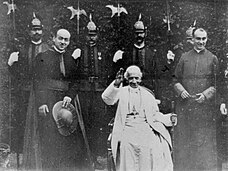
Leo XIII was the first pope whose voice was recorded. The recording can be found on a compact disc of Alessandro Moreschi's singing; a recording of his praying of the Ave Maria is available on the web.[91] He was also the first pope to be filmed by a motion picture camera. He was filmed in 1896 by inventor, W. K. Dickson, and blessed the camera while being filmed.[92] The video contains three segments: the pope on a throne, the pope arriving in a horse-drawn carriage, the pope taking a seat on a bench.[93] Born in 1810, he is also the earliest-born known person to appear in a film.[94]
In the 2024 film, Cabrini, Pope Leo XIII is depicted by Giancarlo Giannini in several scenes offering his support to Mother Cabrini for her mission in the United States in 1889 and thereafter.
See also
[edit]- List of encyclicals of Pope Leo XIII
- Cardinals created by Leo XIII
- Distributism
- List of popes
- List of popes by length of reign
- Papal Navy
- Prayer to Saint Michael
- Restoration of the Scottish hierarchy
Notes
[edit]- ^ Portrait from the archives of the United States Library of Congress
- ^ Italian: [dʒoakˈkiːno vinˈtʃɛntso raffaˈɛːle luˈiːdʒi ˈpettʃi]; English: Joachim Vincent Raphael Louis Pecci.
- ^ Leo is said to have been the last Pope to have directly composed his writings in Latin, rather than have them translated into Latin.[5]
References
[edit]- ^ Gifford, Don (1982). Joyce Annotated: Notes for Dubliners and A Portrait of the Artist as a Young Man. University of California Press. p. 106. ISBN 978-0-520-04610-8.
- ^ "Vincenzo Gioacchino Raffaele Luigi Pecci, aka Pope Leo XIII". www.familysearch.org. Retrieved 3 January 2023.
- ^ Kühne 1880, p. 7.
- ^ Kühne 1880, p. 12.
- ^ Stravinskas, P., On Pope John XXIII’s opening Address at the Second Vatican Council, The Catholic World Report, published and archived on 11 October 2022, accessed on 1 November 2024
- ^ Hayes, Carlton J.H (1941). A Generation of Materialism 1871–1900. p. 142.
- ^ a b c d e f g James Martin Miller (1908). "The life of Pope Leo XIII: containing a full and authentic account of the illustrious pontiff's life and work". Retrieved 21 February 2022.
- ^ Kühne 1880, p. 20.
- ^ Kühne 1880, p. 23.
- ^ a b c "Catholic Encyclopedia : Pope Leo XIII". www.newadvent.org.
- ^ Kühne 1880, p. 24.
- ^ Kühne 1880, p. 31.
- ^ Kühne 1880, p. 37.
- ^ a b Miranda, Salvador. "Pecci, Gioacchino", The Cardinals of the Holy Roman Church
- ^ Kühne 1880, p. 52.
- ^ Laatste Nieuws (Het) 1 January 1910
- ^ Kühne 62
- ^ Kühne 1880, p. 66.
- ^ Lang, Ariella (2008). A Modern Inquisition and the Unification of Italy (1st ed.). United Kingdom: Palgrave MacMillan. p. 178. ISBN 978-1-349-37407-6.
- ^ "Notices of books". The Dublin Review. 104: 483. 1888.
- ^ Kühne 1880, p. 76.
- ^ Kühne 1880, p. 78.
- ^ a b "Pope Leo XIII". New Advent. 1910. Retrieved 12 February 2022.
- ^ Kühne 1880, p. 102.
- ^ Kühne 1880, p. 105.
- ^ Kühne 1880, p. 129.
- ^ a b c O'Reilly, D.D., Bernard (1886). Life of Pope Leo XIII. Jubilee edition.
- ^ a b c d e Hutton, Arthur Wollaston; Bryant, Margaret (1911). . Encyclopædia Britannica. Vol. 16 (11th ed.). pp. 437–439.
- ^ a b Roger-François-Marie Aubert. "Leo XIII". Britannica. Retrieved 12 February 2022.
- ^ Aeterni Patris – On the Restoration of Christian Philosophy (encyclical), Catholic forum, 4 August 1879, archived from the original on 25 February 2007.
- ^ Pecci, Vincenzo Gioacchino Raffaele Luigi (14 March 1891), Ut Mysticam (in Latin).
- ^ "Domus Sanctae Marthae & The New Urns Used in the Election of the Pope". EWTN. 22 February 1996. Archived from the original on 12 July 2018. Retrieved 15 February 2010.
- ^ Nesi, Thomas (2008). Poison Pills: The Untold Story of the Vioxx Drug Scandal (1st ed.). New York: Thomas Dunne Books. pp. 53. ISBN 9780312369590. OCLC 227205792.
- ^ Inciardi, James A. (1992). The War on Drugs II. Mayfield Publishing Company. p. 6. ISBN 978-1-55934-016-8.
- ^ The Elusive Secret of Long Life. Arizona Republican. (9 March 1903). p. 2
- ^ "Pope Leo XIII and his Household" in The Century Illustrated Monthly Magazine, p. 596
- ^ Ross, Ronald J. (1998). The failure of Bismarck's Kulturkampf: Catholicism and state power in imperial Germany, 1871–1887. Washington, DC: Catholic University of America Press. ISBN 978-0-81320894-7.
- ^ Emperor), William I.I. (German (1922). Memoirs. pp. 204–207. Retrieved 23 June 2013.
- ^ Coulombe, Charles A. (2003). A History of the Popes: Vicars of Christ. MJF Books. pp. 404–405.
- ^ Fehér, Ferenc (1990). The French Revolution and the Birth of Modernity. University of California Press. p. 55. ISBN 9780520071209. Archived from the original on 29 May 2010. Retrieved 17 September 2021.
- ^ Schmidlin 1934, p. 409.
- ^ Schmidlin 1934, p. 413.
- ^ Schmidlin 1934, p. 414.
- ^ a b Martire, Egilberto (1951). Enciclopedia Cattolica [Catholic Encyclopedia] (in Italian). Vol. 7. Firenze: Casa Editrice G. C. Sansoni.
- ^ Pecci, Vincenzo Gioacchino Raffaele Luigi, Sæpe nos (in Latin), New Advent.
- ^ "The Public Schools". Minneapolis Daily Times. Vol. VIII (1,630 ed.). Minneapolis, Minnesota. 19 March 1894. p. 5. Retrieved 15 August 2022.
- ^ LLC, CRIA. "CRIA: Commercial Research Image Archives". www.criaimages.com. Archived from the original on 29 November 2019.
- ^ Leopold, Robert S. (August 1994), "A Guide to Early African Collections in the Smithsonian Institution", National Museum of Natural History: 29
- ^ McEachen, A. D. (February 1972), "Letters and lectures of Captain Little", Naval War College Review, 24 (6): 89–91, JSTOR 44639691
- ^ Pecci, Vincenzo Gioacchino Raffaele Luigi (18 April 1897). "Trans Oceanum, Litterae apostolicae, De privilegiis Americae Latinae" [Over the Ocean, Apostolic letter on Latin American privileges] (in Latin). Rome, IT: Vatican. Retrieved 23 June 2013.
- ^ Caivano, Tomas (1907), Historia de la guerra de América entre Chile, Perú y Bolivia [History of the American war between Chile, Peru and Bolivia] (in Spanish).
- ^ Mathias, Joseph Benedict (June 2015). "Priestly Formation in Indian Context :A New Pedagogy for Integral Formation of Candidates to Priesthood in India". Catholic Theology and Thought (75): 11–45.
- ^ "Taft's Curious Connection with the Church - 1901-2000 Church History". Christianity.com. Retrieved 24 June 2024.
- ^ The Italian American Experience. An Encyclopedia. 2003. p. 21.
- ^ Kühne 1880, p. 247.
- ^ Henry Charles Lea (2002), A History of Auricular Confession and Indulgences in the Latin Church, Adamant Media Corp. ISBN 1-4021-6108-5 p. 506
- ^ Francis de Zulueta (2008), Early Steps In The Fold, Miller Press, ISBN 978-1-4086-6003-4 p. 317
- ^ Chasle, Louis (1906), Sister Mary of the Divine Heart, Droste zu Vischering, religious of the Good Shepherd, 1863–1899, London: Burns & Oates.
- ^ Ball, Ann (2003), Encyclopedia of Catholic Devotions and Practices, Our Sunday Visitor, p. 166, ISBN 978-0-87973-910-2.
- ^ Vatican News, Pope’s prayer intentions for 2022, accessed 2 June 2023
- ^ Divino Afflante Spiritu, 1–12.
- ^ von Pastor, Ludwig (1950), Errinnerungen (in German).
- ^ Frederick William Faber (1858). The foot of the Cross; or, The sorrows of Mary. Thomas Richardson and Son. p. 448.
- ^ "Co-Redemptrix as Dogma? : University of Dayton, Ohio". udayton.edu. Retrieved 7 July 2020.
- ^ "Pope Francis on 'Co-Redemptrix'". cruxnow.com. 12 December 2019. Retrieved 7 July 2020.
- ^ Clarke, Richard Henry (1903). The Life of His Holiness Pope Leo XIII. Philadelphia: P.W. Ziegler & Co. p. 607. Retrieved 12 February 2022.
- ^ "Australian Cardinal Dead". The New York Times. 17 August 1911. Retrieved 12 February 2021.
- ^ Hopkins, John Castell (1924). The Canadian Annual Review of Public Affairs. Toronto. p. 458. Retrieved 12 February 2022.
{{cite book}}: CS1 maint: location missing publisher (link) - ^ "Missia Jakob (1838–1902)". Dizionario Biografico dei Friulani (in Italian). Retrieved 12 February 2022.
- ^ B. Miller (21 January 2015). "An Armenian As Pope? – A British Diplomatic Report on Cardinal Agagianian, 1958". Horizon Weekly. Retrieved 12 February 2022. First published: Window Quarterly, Vol. V, No. 3 & 4, 1995, pp. 11–13.
- ^ a b c d Salvador Miranda. "Lep XIII (1878–1903)". The Cardinals of the Holy Roman Church. Retrieved 12 February 2022.
- ^ "Bienheureux Pierre Berthelot". Nominis (in French). l'Eglise Catholique en France. Retrieved 8 March 2012.
- ^ "St. Cosmas – Saints & Angels". Catholic Online. Retrieved 15 February 2010.
- ^ "Like a perpetual sickness" – "Die Gebete nach der hl. Messe", Theol-Prakt. Quartalschrift 87 (1934), 162–163
- ^ a b c "The Illness of His Holiness". The Pilot. 25 March 1899. Retrieved 21 February 2022.
- ^ a b c d e "The Illness and Death of the Pope". The Lancet. 162 (4169): 253–255. 25 July 1903. doi:10.1016/S0140-6736(01)50670-4. Retrieved 21 February 2022.
- ^ a b "Pope Leo XIII suffering from severe attack of pneumonia". The Lafayette News. 11 July 1903. Retrieved 7 February 2022.
- ^ a b c "Pope Leo XIII facing death". The Pilot. 11 July 1903. Retrieved 10 February 2022.
- ^ a b "Leo forecasts death, expresses desire that Gotti succeed him". The Saint Paul Globe. 6 July 1903. Retrieved 7 February 2022.
- ^ "Lumen de coelo nunc est lumen in coelo". The Catholic Telegraph. 23 July 1903. Retrieved 7 February 2022.
- ^ John-Peter Pham, Heirs of the Fisherman: Behind the Scenes of Papal Death and Succession, (Oxford University Press, 2004), 98.
- ^ "Oldest pope". guinnessworldrecords.com. Guinness World Records Limited. Retrieved 18 February 2024.
- ^ Scribner, Herb. "Pope Benedict XVI dies at 95". axios.com. Axios. Retrieved 18 February 2024.
- ^ Fisher, Ian; Donadio, Rachel (31 December 2022). "Benedict XVI, First Modern Pope to Resign, Dies at 95". The New York Times. Retrieved 28 December 2023.
- ^ "A look at the oldest popes of history, including Francis". aleteia.org. Aleteia SAS. 16 December 2021. Retrieved 18 February 2024.
- ^ Ott, Michael (1909). . Catholic Encyclopedia. Vol. 6.
- ^ "Pope Adrian I - PopeHistory.com". popehistory.com. 27 January 2017. Retrieved 26 March 2024.
- ^ "Popes Buried in St. Peter's". stpetersbasilica.info. Retrieved 5 November 2022.
- ^ "The pope says he wants to be buried in the Rome basilica, not in the Vatican". AP News. 13 December 2023. Retrieved 13 December 2023.
- ^ Pope Paul VI (1964), Ecclesiam Suam, paragraph 67, accessed on 4 September 2024
- ^ Pope Leo XIII, 1810–1910, Archive, 30 November 1902.
- ^ Abel, Richard (1 August 2004), Encyclopedia of early cinema, Taylor & Francis, p. 266, ISBN 978-0-415-23440-5.
- ^ "American role in first-ever papal film scrubbed by Vatican due to 'lascivious' use". Crux. 13 November 2023. Retrieved 18 May 2024.
- ^ "Restored 1896 Footage May Reveal New Details Of Pope Leo XIII, Earliest-Born Person On Film". Religion Unplugged. 22 October 2021. Retrieved 18 May 2024.
Bibliography
[edit]In English
[edit]- Chadwick, Owen. A History of the Popes 1830–1914 (2003). online Archived 24 May 2018 at the Wayback Machine pp 273–331.
- Chadwick, Owen. The Popes and European Revolution (1981) 655pp excerpt; also online Archived 26 November 2020 at the Wayback Machine
- Duffy, Eamon (1997), Saints and Sinners, A History of the Popes, Yale University Press.
- Thérèse of Lisieux (1996), Story of a Soul – The Autobiography of St. Thérèse of Lisieux, Clarke, John Clarke trans (3rd ed.), Washington, DC: ICS.
- Quardt, Robert, The Master Diplomat; From the Life of Leo XIII, Wolson, Ilya trans, New York: Alba House.
- O'Reilly, Bernard (1887), Life of Leo XIII – From An Authentic Memoir – Furnished By His Order, New York: Charles L Webster & Co.
In German
[edit]- Ernesti, Jörg (2019), Leo XIII – Papst und Staatsmann, Herder (in German), Freiburg.
- Bäumer, Remigius (1992), Marienlexikon [Dictionary of Mary], Eos (in German), et al, St Ottilien.
- Franzen, August; Bäumer, Remigius (1988), Papstgeschichte (in German), Freiburg: Herder.
- Kühne, Benno (1880), Papst Leo XIII [Pope Leo XIII] (in German), New York & St. Louis: C&N Benzinger, Einsideln.
- Quardt, Robert (1964), Der Meisterdiplomat [The Master Diplomat] (in German), Kevelaer, DE: Butzon & Bercker
- Schmidlin, Josef (1934), Papstgeschichte der neueren Zeit (in German), München
{{citation}}: CS1 maint: location missing publisher (link).
In Italian
[edit]- Regoli, Roberto (2009). "L'elite cardinalizia dopo la fine dello stato pontificio". Archivum Historiae Pontificiae. 47: 63–87. JSTOR 23565185.
Further reading
[edit]- Richard H. Clarke (1903), The Life of His Holiness Leo XIII, Philadelphia: P. W. Ziegler & Co.
- Hutton, Arthur Wollaston; Bryant, Margaret (1911). . Encyclopædia Britannica. Vol. 16 (11th ed.). pp. 437–439.
External links
[edit]- Pecci, Vincenzo Gioacchino Raffaele Luigi. "Encyclicals and other documents" (Etexts).
- "Pope Leo XIII" (texts & biography). Vatican City: The Vatican.
- "Pope Leo XIII, overview of pontificate". Catholic Community Forum. Archived from the original on 3 June 2004.
- "Pope Leo XIII in Carriage" (silent film, available in UK only). 1898 – via BFI.
The Pope arrives in a carriage and bestows a blessing
- Film of Pope Leo XIII in 1896 on YouTube with recording of Leo XIII chanting the Ave Maria in Latin in 1903
- Colorized film of Pope Leo XIII in 1896 on YouTube
- "Pope Leo XIII" (text with concordances and frequency list). Intra text.
- Works by or about Pope Leo XIII at the Internet Archive
- Keller, Rev. Joseph E., ed. (1883). Life and Acts of Pope Leo XII (New and Enlarged ed.). New York, Cincinnati, and St. Louis: Benziger Brothers – via Internet Archive.
- Works by Pope Leo XIII at LibriVox (public domain audiobooks)

- Newspaper clippings about Pope Leo XIII in the 20th Century Press Archives of the ZBW
- Pope Leo XIII
- 1810 births
- 1903 deaths
- 19th-century Italian Roman Catholic titular archbishops
- 19th-century popes
- 20th-century popes
- Angelic visionaries
- Anti-Marxism
- Anti-Masonry
- Apostolic nuncios to Belgium
- Burials at the Archbasilica of Saint John Lateran
- Camerlengos of the Holy Roman Church
- Cardinals created by Pope Pius IX
- Critics of atheism
- Critics of Marxism
- Distributism
- House of Pecci
- Integralism
- Italian anti-communists
- Italian male non-fiction writers
- Italian popes
- Italian religious writers
- Italian Roman Catholic writers
- Occupational safety and health
- Participants in the First Vatican Council
- People from the Metropolitan City of Rome Capital
- Popes
- Thomists

